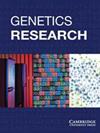Scrutinizing Deleterious Nonsynonymous SNPs and Their Effect on Human POLD1 Gene
IF 2.1
4区 生物学
Q4 GENETICS & HEREDITY
引用次数: 2
Abstract
POLD1 (DNA polymerase delta 1, catalytic subunit) is a protein-coding gene that encodes the large catalytic subunit (POLD1/p125) of the DNA polymerase delta (Polδ) complex. The consequence of missense or nonsynonymous SNPs (nsSNPs), which occur in the coding region of a specific gene, is the replacement of single amino acid. It may also change the structure, stability, and/or functions of the protein. Mutation in the POLD1 gene is associated with autosomal dominant predisposition to colonic adenomatous polyps, colon cancer, endometrial cancer (EDMC), breast cancer, and brain tumors. These de novo mutations in the POLD1 gene also result in autosomal dominant MDPL syndrome (mandibular hypoplasia, deafness, progeroid features, and lipodystrophy). In this study, genetic variations of POLD1 which may affect the structure and/or function were analyzed using different types of bioinformatics tools. A total of 17038 nsSNPs for POLD1 were collected from the NCBI database, among which 1317 were missense variants. Out of all missense nsSNPs, 28 were found to be deleterious functionally and structurally. Among these deleterious nsSNPs, 23 showed a conservation scale of >5, 2 were predicted to be associated with binding site formation, and one acted as a posttranslational modification site. All of them were involved in coil, extracellular structures, or helix formation, and some cause the change in size, charge, and hydrophobicity.审查有害的非同义snp及其对人类POLD1基因的影响
POLD1(DNA聚合酶δ1,催化亚基)是一种蛋白质编码基因,编码DNA聚合酶δ(Polδ)复合物的大催化亚基(POLD1/p125)。出现在特定基因编码区的错义或非同义SNPs(nsSNPs)的结果是替换单个氨基酸。它还可以改变蛋白质的结构、稳定性和/或功能。POLD1基因突变与结肠腺瘤性息肉、结肠癌癌症、癌症(EDMC)、癌症和脑肿瘤的常染色体显性遗传易感性相关。POLD1基因的这些新突变也会导致常染色体显性MDPL综合征(下颌发育不全、耳聋、类激素特征和脂肪营养不良)。在本研究中,使用不同类型的生物信息学工具分析了可能影响POLD1结构和/或功能的遗传变异。从NCBI数据库中总共收集了17038个POLD1的nsSNPs,其中1317个是错义变体。在所有错义nsSNPs中,有28个被发现在功能和结构上是有害的。在这些有害的nsSNPs中,23个表现出>5的保守性,2个被预测与结合位点的形成有关,1个作为翻译后修饰位点。它们都参与了螺旋、细胞外结构或螺旋的形成,其中一些导致了大小、电荷和疏水性的变化。
本文章由计算机程序翻译,如有差异,请以英文原文为准。
求助全文
约1分钟内获得全文
求助全文
来源期刊

Genetics research
生物-遗传学
自引率
6.70%
发文量
74
审稿时长
>12 weeks
期刊介绍:
Genetics Research is a key forum for original research on all aspects of human and animal genetics, reporting key findings on genomes, genes, mutations and molecular interactions, extending out to developmental, evolutionary, and population genetics as well as ethical, legal and social aspects. Our aim is to lead to a better understanding of genetic processes in health and disease. The journal focuses on the use of new technologies, such as next generation sequencing together with bioinformatics analysis, to produce increasingly detailed views of how genes function in tissues and how these genes perform, individually or collectively, in normal development and disease aetiology. The journal publishes original work, review articles, short papers, computational studies, and novel methods and techniques in research covering humans and well-established genetic organisms. Key subject areas include medical genetics, genomics, human evolutionary and population genetics, bioinformatics, genetics of complex traits, molecular and developmental genetics, Evo-Devo, quantitative and statistical genetics, behavioural genetics and environmental genetics. The breadth and quality of research make the journal an invaluable resource for medical geneticists, molecular biologists, bioinformaticians and researchers involved in genetic basis of diseases, evolutionary and developmental studies.
 求助内容:
求助内容: 应助结果提醒方式:
应助结果提醒方式:


